|

Come journey with us on this lifetime
adventure
to the magical and mysterious land
of the Celts, Druids,
Merlin, ancient sacred sites and earth mysteries!
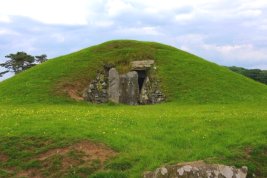
Bryn Celli Ddu Burial Chamber on Angelsey Island
Photo Courtesy of
www.vanderveldephotography.com/
Experience a remarkable land which was once home to the Celts, the Druids, Merlin, and the Holy Grail.
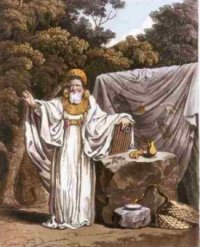
Welsh history alludes to a very ancient and enigmatic sect of Druids that may be the very first wave of magician priests in the British Isles,
even predating the Celtic
Druids by hundreds or even thousands of years.
Both historical documents in Wales,
as well as the rhythmic poems regularly recited by the Welsh Bards,
mention an obscure Druid sect known as the Pheryllt, a name denoting “metallurgists” and “alchemists.”
The researchers who have studied these documents and poems tout the Pheryllt as being the incipient culture bearers
and teachers of Druidism throughout the British Isles.
Certain clues discovered within the Welsh texts imply that the esoteric wisdom of the Pheryllt
was once taught within certain Druid academies in the area of Snowdon in Wales,
and possibly on the Isle of Anglesey, which has been referred to in ancient texts as the “Isle of Teaching.”
In Snowdon, which eventually became their principal headquarters,
the Pheryllyt founded a city of spiritual light known in Welsh terminology as the “ambrosial city of Emrys.”
Emrys is also remembered as “Dinas Affaraon,” the “place of the Higher Powers,”
or the place where a Druid could achieve the apex of his or her higher spiritual powers and consciousness.

Move through the breath taking countryside of Wales and learn the truth behind its fantastic local legends
of witches and wizards, giants and dwarfs, and renowned heroes.
Still unknown and untouched by most mystery hunters, Wales will provide you with the same
quiet, mystical and profound experience that its earliest inhabitants once regularly enjoyed.
You’ll have time for meditation
in many of the places we’ll visit.
This unique sacred pilgrimage tour is designed for seekers interested in
the mystery and sacredness of life,
with a desire to know and understand where we've come from.
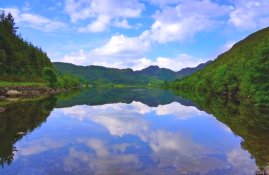
Snowdonia
Photo Courtesy of
www.vanderveldephotography.com/
Join us for this trip-of-a-lifetime in WALES,
the ultimate transformative spiritual adventure, as you experience: :
* The beautiful mountain village of Betwys Y Coed
* Snowdonia National Park, with Snowdon Mountain & its Rack and Pinion
Railway to the top!
* Caernarfon Castle, Conwy Castle, Beddgelert Village, including "Gelert's
Grave"
* Bodnant Garden, one of the most beautiful gardens in the UK
* Anglesey Island: Beaumaris Castle, Burial Chambers of
Bryn Celli Ddu,
Bodowyn and Ty Newydd Burial Chamber
& Holy Head Mountain Hut Circles
* Aberystwyth Castle, Cliff Railway, Camera Obscura, Pentre Ifan Dolmen
* St. David’s Cathedral
* Pembroke Castle
* Cardiff: Cardiff Castle & the Welsh Folk Museum

TOUR
PERSONNEL
SPEAKER/MEDITATION FACILITATOR/TOUR DIRECTOR:
Andrea Mikana-Pinkham
Independent Researcher of Megalithic Sites
and Practitioner/Teacher of the Goddess Tradition

Andrea
Mikana-Pinkham is the Founder/Director of
Sacred Sites Journeys.
She is an independent researcher of ancient megalithic sites
and
an avid practitioner and teacher of the Goddess Tradition.
Andrea has received intuitive
messages/downloads from Spirit for many years.
During this sacred pilgrimage she will offer you optional opportunities to learn how
to connect
with and receive your own messages from
the Ancient Land, Nature Spirits, the Ancient Ones and more!
Andrea has been leading our spiritual pilgrimages to many different
sacred sites around the world for the last 25 years.
She is a trained shamanic practitioner, Reiki Grand Master of Ichi Sekai
(One World) Reiki,
spiritual counselor and a teacher in the
The Order and Mystery School of the Seven Rays.

ITINERARY
August 9 - 16, 2020
Day 1.
Sunday, August 9. Arrive UK; To Wales
OR Continue to Wales from SSJ's
ENGLAND: Spiritual Journey to Sacred Sites,
August 2 - 9, 2020.
(B - England Group
Only; D)
The
Itinerary below for August 9 - 16, 2020 is being rescheduled.
A
Revised Itinerary for April 11 - 18, 2021 will be posted below soon.
Bookmark this page and check back!
Or email Andrea Mikana-Pinkham at
info@SacredSitesJourneys.com to receive the information when it
becomes available. Thanks!
This Sacred Sites Journeys tour is LAND ONLY.
If you’re only
booking the WALES journey ONLY: Please arrange your international
flights to and from Manchester Airport, England.
IMPORTANT: Please book your flight to
arrive on Sunday, August 9, 2020 so that you can meet our Noon transfer to Betws-y-coed, Wales.
Remember that you will need time to clear Immigration, Baggage Claim and
Customs, and then arrive at the transfer point before Noon. If you’re not
able to arrive in time to meet the transfer, we suggest that you fly in a
day early. There are airport hotels where you can spend the night. This will
also assist you to overcome jet lag and be rested for the beginning of our
journey.
Upon arrival at Manchester Airport, claim your bags and
exit through Customs.
Noon - Meet our local Sacred Sites Journeys tour representative in
the Arrivals Hall
(full details to be announced in the final tour
itinerary, which will be emailed to the group 2 weeks to 10 days before the
journey begins). We board our motor coach for our drive through the
English and Welsh countryside to Betws-y-coed, Wales.
If you’re continuing on from our Sacred Sites
Journey to ENGLAND:
8:00AM - The England group departs Tintagel. We board our motor coach for
our drive through the English and Welsh countryside to Betws-y-coed, Wales.
We'll either stop along the way for an early
lunch on your own with the group, or offer you the opportunity to order a
box lunch from the hotel in Tintagel the day before.
BOTH GROUPS:
3:00PM
- Both groups arrive in Betws-y-coed
(BEH-toos uh KO'ed).
The name of this quaint village means
“Prayer House in the Woods” in Welsh, and is thought to refer to
14th Century St. Michael's Church where the yew trees are around five
centuries old. The area around Betws-y-Coed offers a rich and varied
landscape with rivers tumbling from the beautiful but bleak high moorland,
through the ancient oak woodland with its dramatic ravines, before meeting
at Betws-y-Coed from where the river then flows majestically through the
lush and fertile meadows of the Conwy Valley on its journey to the sea at
Conwy. Life in the area has for centuries been shaped by the landscape, and
this sense of closeness to nature can still be felt today. Betws-y-coed has
been the premier inland resort in North Wales since the Victorian age. Lying
in the shelter of the Gwydir Forest Park, it’s an
attractive village with its stone built houses and numerous walks for people
of all abilities. There are many quality shops in the village, and numerous
places to eat.
We check in at the hotel. Time to rest and or explore the area on your
own.
6:00PM – Group Welcome Meeting facilitated by Tour
Director Andrea Mikana-Pinkham, a time to come together and
introduce ourselves.
7:00PM – Group Welcome Dinner at the hotel.
Followed by a good night's rest!
Overnight Betws-y-coed. Waterloo Hotel &
Lodge.
Day 2. Monday, August 10, 2020. Caernarfon Castle, Snowdon Mountain &
Rack and Pinion Railway (B/D)
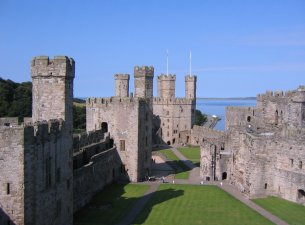
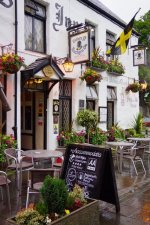
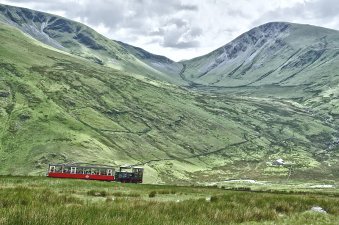
Left to Right: Caernarfon Castle
Wikipedia ;
Caernarfon
www.VanderVeldePhotography.com ;
Snowdon Mountain Railway
Wikipedia
Breakfast at your leisure
9:00AM – Depart the hotel and board our motorcoach for our drive to Caernarfon Castle.
10:00AM – Arrive and visit one of the most impressive of all the castles
built by Edward I and
one of Europe's great medieval fortresses. Set on a peninsula bounded by the Menai Strait and at the heart
of North Wales, Caernarfon became the English administrative center. This is the castle where each Prince of Wales is
invested. King Edward seems to have gone to considerable lengths to give substance to the tradition linking Caernarfon with
imperial Rome. The king must have known that the Roman fort of Segontium, lying just above the modern town, was inseparably
associated in legend with Magnus Maximus, the usurper emperor. Maximus appears as the Macsen Wledig of the Mabinogion,
the earliest prose stories of the literature of Britain. The stories were compiled in Middle Welsh in the 12th–13th centuries
from earlier oral traditions. There are two main source manuscripts, created c. 1350–1410, as well as a few earlier fragments.
It is Segontium which provides the background to King Edward's dream of journeying from Rome into a land of high mountains
facing an island. There he saw a great city with towers of many colors and eagles fashioned out of gold. Thus it was that at
Caernarfon, the walls were given a prominent patterning with bands of different colored stone. Moreover, the towers were
constructed in an angular fashion rather than the usual rounded form of, for example, Conwy or Beaumaris. It's difficult to
escape the conclusion that Edward was drawing upon symbolism, and turned for inspiration to the great city of Constantinople.
There, in the eastern successor to Rome and one of the wonders of the ancient world, the fifth century walls bear a striking
resemblance to this late thirteenth century castle.
11:30AM – Lunch on your own and free time to explore in Caernarfon.
Its Celtic heart yet beats strong. Northwest Wales was the last stronghold of the Celts during centuries of Anglo Saxon/Norman
invasions, so the Welsh roots of Caernarfon run especially deep. Welsh is the predominant language there, so
(while most everyone speaks English) signs are in Welsh and locals will often be heard speaking it in pubs (and elsewhere).
1:30PM – Depart to Mount Snowdon, located in
Snowdonia National
Park, where we’ll depart from Llanberis station to take a ride on the rack and pinion railway
up to view the magnificent views from Yr Wyddfa (uhrr WUHTH-va), the mountain summit at 3,560 ft., a journey experienced by some 12 million travelers
since 1896. The ancient Snowdonian mountains, thrust upwards by volcanic forces 450 million years ago, once grew to heights of almost
33,000 ft! Over eons the wind and rain and successive ice ages have sculpted them to their current form; with Snowdon being the
highest summit in England and Wales. The roundtrip journey takes approximately two and a half hours, which includes a 30 minute stop-over before returning to Llanberis.
5:30PM - Return to Betws-y-coed.
7:00PM – Group dinner at the hotel or at a local restaurant within a short walking distance.
Overnight Betws-y-coed. Waterloo Hotel & Lodge.
Day 3. Tuesday, August 11. Conwy Castle, Beddgelert
and Bodnant Garden (B/Box Lunch)
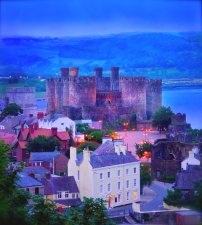
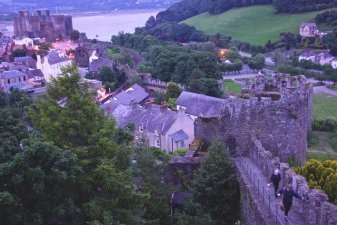
Left to Right: Conwy Castle and Conwy
Castle Walk
www.VanderVeldePhotography.com
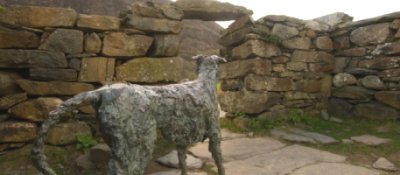
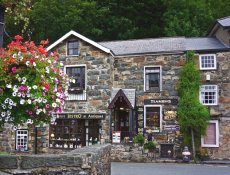
Left to Right: Beddgelert-Gelert's Grave
National Trust ; Beddgelert Village
www.VanderVeldePhotography.com
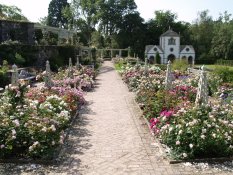
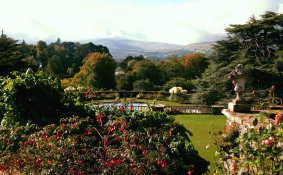
Left to Right: Bodnant Garden
Wikipedia and
Wikipedia
Breakfast at your leisure
9:00AM –
Depart the hotel and board our motorcoach for our drive to Conwy, which boasts Great Britain’s
tiniest house, (built within the city wall). Time allowing, you might be able to take an optional brief tour of this adorable structure.
Or, if there's not enough time, we'll just marvel at it from the outside.
Our main visit in Conwy is to Conwy Castle, a World Heritage Inscribed site, which is a a gritty, dark-stoned
fortress which has the rare ability to evoke an authentic medieval atmosphere. The first time that visitors catch sight of the castle, commanding a rock
above the Conwy Estuary and demanding as much attention as the dramatic Snowdonia skyline behind it, they know they are in
the presence of a historic site which still casts a powerful spell. Conwy, constructed by the English monarch Edward I
between 1283 and 1289 as one of the key fortresses in his 'iron ring' of castles to contain the Welsh, was built to prompt such a humbling reaction.
A distinguished historian wrote of Conwy, "Taken as a whole, Conwy's incomparably the most magnificent of Edward I's Welsh fortresses".
In comparison to other great Edwardian castles it's also relatively straightforward in design, a reflection of the inherent strength of its siting.
There are no concentric 'walls within walls' here, because they weren't needed. Conwy's
massive military strength springs from the rock on which it stands and seems to grow naturally. Soaring
curtain walls and eight huge round towers give the castle an intimidating presence undimmed by the passage of time.
The views from the battlements are breathtaking looking out across mountains and sea and down to the roofless shell of the castles 125ft. Great Hall.
It's from these battlements that visitors can best appreciate Conwy's other great glory, its ring of town walls. Conwy is the classic walled town.
Its circuit of walls, over three quarters of a mile long and guarded by no less than 22 towers, is one of the finest in the World.
11:00AM – Depart to Beddgelert
11:30AM – Arrive Beddgelert, another picturesque mountain town, with beautiful gray-stone
architecture, a babbling river, a mountain copper mine (in use since the Romans, and possibly before), and loads of superstition, beauty, and lore.
It’s a breathtaking setting! We'll take a short walk south of the village, following the footpath along the banks of the Glaslyn River,
which leads to Beddgelerts most famous historical feature "Gelert's Grave". There are a couple of different legends as to who
"Gelert" was. According to one, the stone monument in the field marks the resting place of "Gelert" the faithful hound
of the medieval Welsh Prince Llywelyn the Great. Other local historians say that Gelert himself was likely
a sixth-century priest (as opposed to a faithful hound). Oh well...you can choose which one you prefer!
- Some legends claim Merlin’s Cave (as well as his birthplace) are also near Beddgelert, while other tales
say his birthplace
is in Scotland or England.
1:00PM – Depart to Bodnant Garden. En-route enjoy your packed lunch.
2:00PM – Arrive and visit the Bodnant Garden, one of the most beautiful gardens in
the UK, spanning some 80 acres and situated above the River Conwy on ground sloping towards the west and looking across the
valley towards the Snowdonia range. The garden has two parts. The
upper garden around Bodnant Hall consists of the terraced
gardens and informal lawns shaded by trees. The lower portion, known as the "Dell" is formed by the valley of the River
Hiraethlyn and contains the Wild garden. An endeavour has been made at Bodnant Garden to grow a wide range of interesting
and beautiful plants from all over the world, particularly those
from China, North America, Europe and Japan that are suited to the
Welsh climate and soil. Also, care has been taken to place the plants in such a way that they enhance each
other and contribute to the general beauty of the garden throughout the seasons. The Garden
is always of interest to amateur and
professional gardeners, artists, photographers, families and tour
groups alike - There's something to enthrall everyone! You'll have free
time to wander around the site and enjoy the Earth Energies
and other delights that
Bodnant Garden has to offer.
4:00PM – Return to Betws-y-Coed.
4:30PM – Arrive at hotel.
Free time. Dinner
is on your own tonight; eat at the hotel or explore in town for a
restaurant.
Overnight Betws-y-coed. Waterloo Hotel & Lodge.
Day 4. Wednesday, August 12. To Anglesey Island: Beaumaris Castle,
Bryn Celli Ddu, Bodowyn Burial Chamber, Ty Newydd Burial Chamber
& Holy Head Mountain Hut Circles (B/L/D)

Beaumaris Castle
Wikipedia
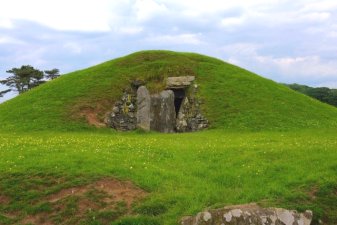
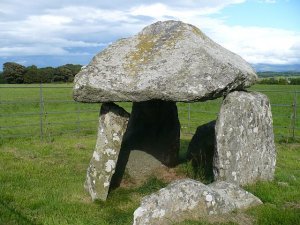
L to R: Bryn Celli Ddu
www.VanderVeldePhotography.com ; Bodowyn Burial Chamber
Wikipedia
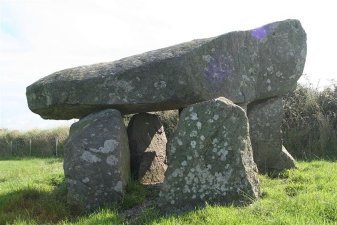
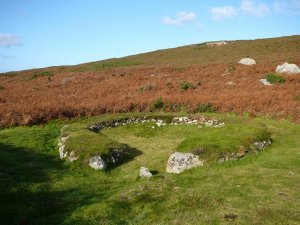
Ty Newydd Burial Chamber
Wikipedia ; Holy Head Mountain Hut Circles
Wikimedia
Breakfast at your leisure
8:00AM – Depart to the Isle of Anglesey,
Ynys Môn in Welsh, situated off the north-west coast of Wales near the beautiful Snowdonia mountain range. It's separated
from the mainland by the Menai Strait, which is spanned by two picturesque bridges, the Menai Bridge and the
Britannia Bridge. Anglesey was known as Mam Cymru "Mother of Wales" during the Middle Ages because its
fertile fields formed the breadbasket for the north of Wales.
9:00AM – Arrive in the historic town of Beaumaris, the site of Beaumaris Castle, the great unfinished masterpiece
built as one of the Iron Ring of North Wales built by
Edward I to stamp his authority on the Welsh. We'll visit this ancient fortress,
a World Heritage inscribed site.
Even though it was never finished, as money and supplies ran out before the fortifications reached their full height,
Beaumaris
is nonetheless an awesome sight, regarded by many as the finest of all the great Edwardian castles in Wales. Begun in 1295CE, it was also
the last.
The king's brilliant military architect James of St George
used all of his experience and inspiration when building this
castle; it was the biggest and most ambitious venture he ever undertook.
In pure architectural terms Beaumaris, the most technically perfect castle in Britain, has few equals. Its ingenious and perfectly symmetrical
concentric 'walls within walls' design, which actually are four successive lines of fortifications, was state of the art for the late
13th century.
The stronghold stands at one end of Castle Street. Closely linked with the history of the town, it was the
beau marais (fair marsh) that Edward chose for a castle and garrison town. From the outside, Beaumaris appears almost handsome, as it sits contentedly
in a scenic setting overlooking mountains and the sea, partially surrounded by a water filled moat. The gate
next to the sea entrance protected the tidal dock which allowed supply ships to sail right up to the castle. There are 14 separate
major obstacles that any attacker would have to overcome, such as hundreds of cleverly sited arrow-slits, as well
as the deadly use of 'murder holes' to defend entrances.
10:30AM – Depart to Bryn Celli Ddu (brin kethlee thee).
11:00AM – Arrive and visit the chambered tomb, which means "Hill (Mound) of the Dark Grove" in Modern Welsh. The original structure on this site was a
circle henge, a bank and 57 foot diameter
ditch with standing stones set in a circle within it.
Neolithic people destroyed the structure when they built a tomb on top of
the site. A 27 foot long passage leads to the burial chamber, with a
large, free-standing pillar inside. There is a cast of the
original stone in the National Museum of Wales in Cardiff. The cast brings out the faint
maze pattern that was carved into it.
12:00PM – Enjoy your packed lunch.
12:30PM – Depart to Bodowyn Burial Chamber
1:00PM – Arrive and visit Bodowyr or Bodowyn Burial Chamber stands on a hillock in a farmer's field with panoramic views of Snowdonia. Its massive, mushroom-shaped capstone was originally supported by four tall standing stones, one of which fell at some point over the last few millennia. A fifth, shorter stone is believed to mark what was once the tomb’s entrance.
Built during the Neolithic Age, it's most likely a passage grave used for communal burial. However, since the site has never been excavated, it's not known who or what is buried there. Originally a mound of earth or rubble would have covered or partially covered the dolmen, and there would have been a passage from the entrance on the southeast to the side of the mound. The mound has since been completely dispersed.
The location of the dolmen is on level, low-lying ground, with Snowdon and the Glyderau visible in the distance and with the Llanberis Pass between them. So there may be some solar or lunar alignment as seen from the entrance, but it remains a mystery as of today.
1:45PM – Depart to Ty Newydd Burial Chamber
2:15PM – Arrive and visit Ty Newydd Burial Chamber, a megalithic dolmen which was built on
a natural outcrop and would originally have been covered with a mound or cairn. The capstone is cracked and rests on three of the
four remaining uprights. The chamber was excavated in August 1935 by Charles Phillips, who found a spread of charcoal with a
hearth at the eastern end, where there was thought to have been a second chamber or passage. There were also five flint flakes,
a burnt flint arrowhead, a small chip from a polished flint an axe, and nine small fragments of pottery. Phillips believed that
the pottery fragments were from the Beaker culture, and thus might represent Bronze Age reuse of an earlier Neolithic monument.
3:00PM – Depart to HolyHead, located in the center of the island. This county town is the main ferry port for travel across the Irish Sea to
Dublin and Llangefni.
3:30PM – Arrive and visit the HolyHead Mountain hut circles, also known as Cytiau'r Gwyddelod
or the Irishmen's Huts. They're one of the best-preserved hut groups in all of Wales and are very impressive reminders of this
remote island's ancient past.
The hut group is located on a level terrace that traverses the southwestern end of Holyhead Mountain. Their precise age is not clear.
Much of the site is thought to date from the Iron Age, but the settlement may have been in existence over an extended period of time
from the Neolithic to the Dark Ages, with different buildings being in use at different times.
Over fifty buildings were recorded during excavations in 1860. The site was examined again between 1978 and 1982. About twenty
huts have been reconstructed. Each one would originally have had a conical roof, supported by poles set on top of a low wall,
covered with turf or thatch. Some of the huts are homesteads; these are mostly circular and hearths, alcoves and a stone trough
have been identified. Others are oval and have a dividing wall, still others are entered by long passages, and some are small,
and may have been used as storerooms or workshops. One building at the northeastern end of the terrace has a walled enclosure
or paddock adjoining. Artifacts found at the site include a broken stone axe, flint arrowheads and pottery fragments from the
late Neolithic or early Bronze Age. A number of Roman coins were found hidden inside one of the huts.
If
there's time and you have the energy to climb 718 feet to the top of the mountain, you'll be rewarded with clear views
across the Irish sea to the Irish mainland and equally fine views to Snowdonia on the Welsh side.
4:30PM – Return to hotel.
5:30PM – Arrive at hotel.
7:00PM – Group dinner at the hotel or at a local restaurant within a short walking distance.
Overnight Betws-y-coed. Waterloo Hotel & Lodge.
Day 5. Thursday. June 4. Thursday, August 13. To Aberystwyth: Aberystwyth Castle,
Cliff Railway, Camera Obscura; to Cardigan (B/D)
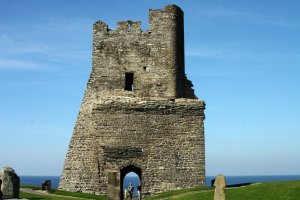
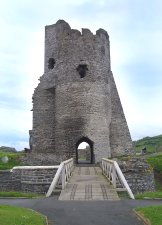
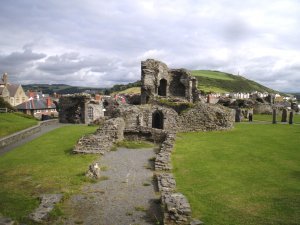
L to R: Aberystwyth Castle - 1
Wikipedia ; Aberystwyth Castle - 2
Wikipedia; Aberystwyth Castle - 3
Wikipedia
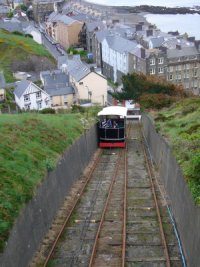
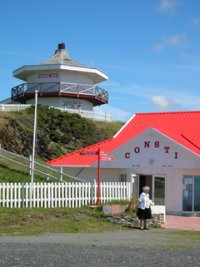
L to R: Aberystwyth - Cliff Railway
Wikipedia ; Aberystwyth -Camera Obscura
Railway Website
Breakfast at your leisure
9:00AM – Check out of the hotel and depart south along the wild and rugged Welsh coast.
11:00AM – Arrive Aberystwyth, "Mouth of the Ystwyth", an ancient market town, administrative centre, community,
and holiday resort in County Ceredigion, located near the confluence of the Ystwyth and the Afon Rivers. There's evidence of habitation
there since the Mesolithic era; it was used as a flint knapping floor for hunter-gatherers making weapons from flint that was
deposited as the ice retreated. There are remains of a Celtic fortress from before 700 BCE.
The recorded history of Aberystwyth dates from the building of a fortress in
1109CE by Gilbert Fitz Richard (grandfather of Richard de Clare,
known as Strongbow, the Cambro-Norman lord who led the Norman invasion of Ireland). He was granted lands and the lordship of Cardigan
by Henry I, including Cardigan Castle. Edward I
replaced Strongbow's castle in 1277, after its destruction by the Welsh. Between the
years 1404 - 1408 Aberystwyth Castle was in the hands of
Owain Glyndŵr, but finally surrendered to the English. Shortly after
this, the town was incorporated in a Royal charter granted by
Henry VIII.
In modern times Aberystwyth hosted the National Eisteddfod, the Welsh festival of literature, music and performance, in 1865, 1916,
1952 and 1992.
Visit Aberystwyth Castle with the group, a Grade I listed Edwardian fortress built in the late 13th century during a national
uprising by Owain Glyndŵr, or Owen Glendower, as his name has been anglicized to. He was a Welsh rebel who instigated a fierce and long-running yet ultimately unsuccessful war of
independence against English rule in Wales during the Late Middle Ages. He was the
last native Welshman to hold the title Prince
of Wales.
The Welsh captured the castle in 1404, but it was recaptured by the English four years later. In
1637 it became a Royal mint by
Charles I, and produced silver shillings. The castle was slighted by Oliver Cromwell in 1649.
As for the architecture of the castle, the inner ward was built in a diamond-shaped concentric castle, with a twin D-shaped
gatehouse keep and mural towers at each corner. The outer ward is described as consisting of a "twin D-shaped gatehouse,
a barbican, a rock-cut ditch and a large curtain wall with towers.
After our visit to the castle we'll take the Aberystwyth Cliff Railway to the top of Constitution Hill. It's the longest funicular electric cliff
railway in Britain, and has been transporting visitors to the summit since opening in 1896. From the summit we'll see spectacular
and uninterrupted views of the town, Cardigan Bay, and if the day is clear enough, we may also see the 26 mountain peaks that span
much of the length of Wales.
The carriages are hauled to the summit at a stately 4 miles per hour, and are powered by a powerful motor and high-tensile steel
cables supported by a sophisticated electronic safety system. In the mid-section of the journey the railway is in a deep cutting,
where 12,000 tons of rock was excavated to allow the winding footpath to cross overhead on a series of bridges. Constitution Hill
was the Victorian predecessor of our modern-day theme parks and is still amongst the most popular attractions in the area.
Once at the summit you can also visit one of the world’s largest camera obscuras, which offers a bird’s eye view
of 1000 square miles of land and seascape!
There are also fascinating historical displays, a well-stocked gift shop, and a cafe selling delicious home-made snacks where you can
enjoy a light lunch on your own.
2:00PM – Depart Aberystwyth to Cardigan. The town lies on a tidal reach of the River Teifi at the point where Ceredigion meets
Pembrokeshire. Cardigan was the county town of the historic county and is the second-largest town in Ceredigion.
The settlement at Cardigan was developed around the Norman castle built in the late 11th or early 12th century. In 1176 the
castle was the location of the first National Eisteddfod, a Welsh festival of literature, music and performance. The town became an
important port in the 18th century, but declined by the early 20th century owing to its shallow harbour. The castle underwent restoration in 2014.
4:30PM - Arrive in Cardigan and check in at our hotel located banks of the River Teifi at the estuary at
Gwbert-on-Sea. Take some time to rest or you might want to take a 10-minute taxi ride to visit Cardigan Castle,
which is open to the public.
7:00PM - Group dinner at the hotel.
Overnight Cardigan. Hotel Gwbert.
Day 6. Friday, August 14. Pentre Ifan; St. David’s Cathedral; Pembroke Castle;
To Cardiff (B/Box Lunch/D)
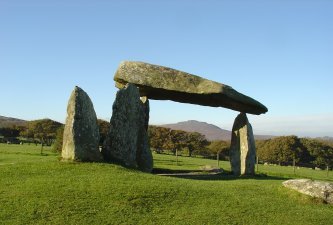
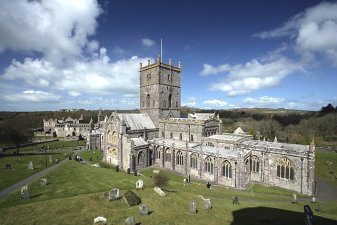
L to R: Pentre Ifan Dolmen
Wikipedia
; St. David's Cathedral
Wikipedia
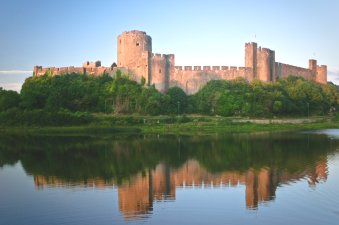
Pembroke Castle
Wikimedia
Breakfast at your leisure
9:00AM
-
Arrive and visit Pentre Ifan "Ifan's Village", which was once known as
Arthurs' Quoit, or Dolmen.
It's a Bronze-Age megalithic site dating from at least 4000 BCE, In ancient times it was
sometimes called “The Womb of Cerridwen.” She was an enchantress in Welsh medieval legend. Her name is derived from the Celtic
word "cerru," meaning cauldron, which symbolizes the transformative power of magic, wisdom, rebirth and creative inspiration.
Medieval Welsh poetry refers to her as possessing the cauldron of poetic inspiration (Awen) and the Tale
of Taliesin recounts her swallowing her servant Gwion Bach who is then reborn through her as the poet Taliesin.
She's regarded by many modern Pagans as the Celtic goddess of rebirth, transformation, and inspiration.
The north-south orientation of the megalith is unusual, as they're usually oriented east-west.
Some researchers say it's probably the finest Welsh hilltop megalith. And though no trace of burials has been found here,
it's possible that it was used for collective burials. Over the several thousand years of its existence it's been denuded of earth.
The magnificent 40 ton horizontal capstone is still in place; its 16ft 6in long and 8ft off the ground. The stones of the chamber
are all of local igneous rock; on the portal stone there is a faint decorative cupmark. The belief of the builders could have been
that the interred soul (or souls) was closer to the Spirit World and also closer to the Sun, whose essence was worshiped as the giver
of life, warmth and abundance. The north-south orientation of the megalith is unusual, as they're usually oriented east-west.
Local legends offer that fairies are sometime seen here. They're described as "little children in clothes like soldiers clothes
and with red caps". Keep your eyes open and believe; you might see them too!
10:30AM – Depart to visit St. David's Cathedral.
11:15AM - Arrive and visit St. David's Cathedral, one of Britain's oldest cathedrals.
The legend of St. David, or Dewi, the patron saint of Wales, claims he was born around 500CE on the
rugged Pembrokeshire coast of southwest Wales. He was the founder of a strict monastic order in the town that bears his name, and
was the most influential clergyman in all Wales during the "Age of Saints." His place of birth and the cathedral built in his
name became one of the most important shrines of medieval Christendom - two pilgrimages to St. David’s equaling one to Rome.
Nowhere in Britain is there a more ancient cathedral
settlement, for it reaches back fourteen centuries and survived the plunder of the
Vikings during the Dark Ages. The cathedral was a major pilgrimage
destination throughout the Middle Ages.
St David chose this wild, beautiful region as the site of his monastery in the 6th century; his shrine is in the purple-stoned cathedral which
is considered the holiest site in Wales due to his relics. Today it's still a living modern church,
with energies from the distant past still reaching out to touch those who
are open to them.
The Norman cathedral, which was rebuilt from an older version in 1131CE, was
situated down in a hollow to avoid the notice of invaders
from the sea, so you can only see the tower until you're right upon the building. Be focused on its "entrance", as it's quite a spectacular sight!
WHAT TO SEE (Partial Excerpt from
www.sacred-destinations.com: Enter by the south door and step into the south aisle of
the nave. Stand at the back of
the nave and notice the arcades lean significantly outward — a problem that has plagued cathedral architects for centuries.
An earthquake in 1248CE didn't help, either! You can feel the sloping lean towards the back of the cathedral as well.
From here you can admire the finely-carved stone screen, which includes a
statue of St. David, in the front of the nave.
Look up to the beautiful wooden ceiling, carved of Irish oak in the early 16th century and embellished with carved pendants.
The carved wooden crucifix or rood suspended from the ceiling is a 20th-century replacement of a medieval version. Over your right
shoulder above the baptismal font is a small rose window, installed in the 1950s. Then, walking around the
stone screen to the
right, along the south aisle, you come to the battered tomb of Bishop Gower, who contributed so much to the cathedral and the
surrounding area, with his effigy on top.
The entrance to the beautiful 15th and 16th-century choir
is next to Edmund's tomb. It's famed for its large collection of
decorated misericords or seats designed out of mercy (Latin misericordia) to support the weight of priests standing throughout
services. Each one is carved from a single block of oak. The hidden position of the misericords released the craftsmen from the forms of
traditional ecclesiastical art to create an often irreverent form of folk art. The images are highly
symbolic satires on the lives
of laity and clergy and moral lessons. The words painted above the seats are the names and offices of those using them at the time.
What's left of the Shrine of St. David (1275) stands in its original position in the Presbytery. The shrine was destroyed
during the Reformation and is empty; his relics are believed to be in the reliquary in the nearby Holy Trinity Chapel.
It was built by Bishop Vaughn (r.1509-22) as his chantry chapel, in the Perpendicular style. A statue of him stands in his chapel.
The chapel's small stone altar is reconstructed from medieval framents, and the fan vaulting of the ceiling includes
the coat of arms of Henry VII. The window allowed the chantry priest celebrating in this chapel to monitor the progress of the simultaneous
masses taking place in the other chapels. The Holy Trinity Chapel also contains the reliquary believed to hold the
bones of St. David and other saints. These were discovered in 1866, buried under the floor of the chapel, then moved
into their present oak casket behind an iron grille in 1920. In 1996, carbon-dating of the bones showed they dated from the 12th
through 14th centuries.
Next to the north transept is the St. Thomas Becket Chapel, which includes a stained glass portrait of St. David.
The Eucharistic elements are also kept here.
In the southeast end of the cathedral is the pink-hued marble Chapel of St. Edward the Confessor. The tomb is
that of the Countess of Maidstone, granddaugther of Bishop Jenkinson (1825-40). From here an ambulatory leads to the Lady Chapel, restored in 1901.
On the wall in the south transept is a fine 17th-century Cretan icon of Elijah being fed by ravens, a rare Eastern
Orthodox touch to a western cathedral. And throughout the cathedral's aisles are tombs and effigies of various medieval priests and knights.
SOME LEGENDS ABOUT DAVID:
1) One alleges that King Arthur was his uncle and that among the "prophecies of Merlin" was a prediction that St. David would
found a bishopric in Wales.
2) In another legend, St. Gildas (born c.500CE) foretold David's birth when a pregnant woman came into the church as he was
preaching. He was struck dumb, and on regaining his power of speech, predicted that she would give birth to a son "with a greater
proportion of the divine spirit than has ever fallen to the share of a preacher."
3) It's said that during a speech at a 6th-century synod a dove
descended on David's shoulder, signifying his eloquence and
guidance by the Holy Spirit. The statue of St. David in the cathedral includes the dove.
3) David died in old age on March 1 in either 589 or 602 CE. His last words are reported to have been, "Brothers and sisters,
be joyful and keep the faith and do the little things which you heard and saw with me."
After our walk through the cathedral, time allowing, find a quiet place to sit and
meditate and / or reflect on what you've received
from your visit to this sacred place.
1:00PM - Depart to Pembroke Castle. En-route enjoy your packed lunch as we travel through Pembrokshire.
2:00PM – Arrive and visit Pembroke Castle, a medieval castle that was the
original family seat of the Earldom of Pembroke. In 1093,
Arnulf of Montgomery built the first
castle at the site when he fortified the promontory beside the Pembroke River during the Norman invasion of Wales. A century later,
the castle was given by Richard I to William Marshal, who became one of the most powerful men in 12th-century Britain.
He rebuilt Pembroke in stone creating most of the structure that remains today. The castle underwent major restoration during the early 20th century and was designated as a Grade I listed building in 1951. Today it's
owned by the Philipps Family, who open it to the public; it's the largest privately-owned castle in Wales.
The inner ward, which was constructed first, contains the huge round keep with its domed roof.
Its original first-floor entrance was through an external stairwell. Inside, a spiral staircase connected its four stories.
The keep's domed roof also has several putlog holes that supported a wooden fighting-platform. If the castle was attacked,
the hoarding allowed defenders to go out beyond the keep's massive walls above the heads of the attackers. The inner ward's
curtain wall had a large horseshoe-shaped gateway. But only a thin wall was
required along the promontory. This section of wall has a small observation turret and a square stone platform. Domestic
buildings including William Marshal's Great Hall and private apartments were within
the inner ward. The 13th century keep is 75 ft. tall with walls up to 20 ft. thick at its base. In the late 13th
century, additional buildings were added to the inner ward, including a new Great Hall. A 55-step spiral staircase
was also created that led down to a large limestone cave, known as Wogan Cavern, beneath the castle. The cave,
which was created by natural water erosion, was fortified with a wall, a barred gateway and arrowslits. It may have served as a
boathouse or a sallyport to the river where cargo or people could have been transferred.
The outer ward was defended by a large twin-towered gatehouse, a barbican and several round towers.
The outer wall is 16 ft. thick in places and constructed from Siltstone ashlar.
Although Pembroke Castle is a Norman-style enclosure castle with great keep, it's more accurately described as a linear fortification because, like the later 13th-century castles at
Caernarfon and Conwy, it was built on a rock promontory surrounded by water. This meant that attacking forces could only assault on
a narrow front. Architecturally, Pembroke's thickest walls and towers are all concentrated on its landward side facing the town,
with Pembroke River providing a natural defense around the rest of its perimeter.
3:00PM – Depart to Cardiff.
5:30PM – Arrive and check in at our hotel. Free time.
Cardiff is the capital of Wales and its largest city. The eleventh-largest city in the United Kingdom, it is Wales's chief commercial center,
the base for most national cultural institutions and Welsh media, and the seat of the National Assembly for Wales.
The anglicised form Cardiff is derived from Caerdyf. The antiquarian William Camden (1551–1623) suggested that the name Cardiff may derive from
*Caer-Didi ("the Fort of Didius"), a name supposedly given in honor of Aulus Didius Gallus, governor of a nearby province at the time
when the Roman fort was established. Although some sources repeat this theory, it has been rejected on linguistic grounds by some
modern scholars.
Until the Roman conquest of Britain, Cardiff was part of the territory of the Silures – a Celtic British tribe that flourished in
the Iron Age – whose territory included the areas that would become known as Breconshire, Monmouthshire and Glamorgan.
7:00PM - Group dinner at the hotel.
Overnight Cardiff. Clayton Hotel.
Day 7.
Saturday, August 15. Cardiff Castle and the Welsh Folk Museum;
Farewell Dinner (B/D)
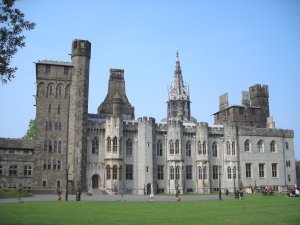
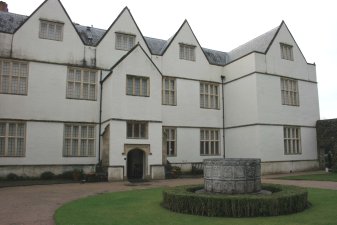
L to R: Cardiff Castle
Wikipedia ;
Welsh Folk Museum - St. Fagan's Castle
Wikimedia
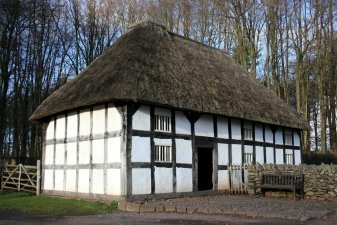
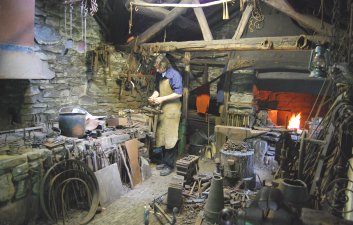
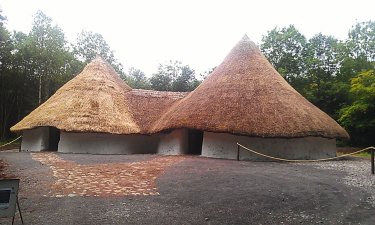
L to R: Welsh Folk
Museum - Abernodwydd Farmhouse
Wikipedia ; Smithy
Wikipedia ; Iron Age Roundhouses
Wikimedia
Breakfast at your leisure
9:30AM -
Depart for our visit to Cardiff Castle. The
medieval castle and Victorian Gothic revival mansion are located in the city center.
Of all the castles in the UK, Cardiff Castle is one of the most amazing and richly complex sites, with a story that spans over
2,000 years. The Castle you see today is at once a Roman fort, an impressive Norman castle and an extraordinary Victorian
Gothic fantasy palace, created for one of the world’s richest men.
The original motte and bailey castle was built in the late 11th century by Norman invaders on top of a 3rd-century Roman fort.
The castle was commissioned either by William the Conqueror or by Robert Fitzhamon, and formed the heart of the medieval town
of Cardiff. In the 12th century the castle was begun to be rebuilt in stone, probably by Robert of Gloucester, with a shell
keep and defensive walls being erected. Further work was conducted by the 6th Earl of Gloucester in the second half of the
13th century.
Cardiff Castle was repeatedly involved in the conflicts between the Anglo-Normans and the Welsh, being attacked several
times in the 12th century, and stormed in 1404 during the revolt of Owain Glyndr.
There is much more to the history, to be explored on site after
our guided audio tour, which will allow you to explore at your own pace. Here are some options:
1) Take a House Tour which takes you through some of the most amazingly opulent, highly decorated rooms
you will ever see. Amongst the rooms you will visit with your expert guide are the Winter Smoking Room, The Nursery,
Lord Bute’s Bedroom and The Roof Top Garden. The tour runs every day on the hour and lasts approximately 50 minutes
(additional charge).
2) Castle Apartments - A Gothic Fantasy Palace: For the ultimate Victorian medieval dream world,
see the spectacular fairy-tale apartments, rich with murals, gilding and elaborate wood carvings, stained glass and marble,
created by art-architect William Burges for the 3rd Marquess of Bute.
3) The Norman Keep - The twelve-sided Keep at Cardiff is the finest in Wales and is known as a ‘shell’
keep. Its outer walls provided a shell for smaller buildings within it. From the top of the Keep the panoramic views of
the city are breathtaking and to the north you can see as far as The Norman Keep
The twelve-sided Keep at Cardiff is the finest in Wales and is known as a ‘shell’ keep. Its outer walls provided a shell
for smaller buildings within it. From the top of the Keep the panoramic views of the city are breath-taking and to the
north you can see as far as Castell Coch, the "Red Castle", over six miles away. There are approximately 50 steep stone steps leading to the Keep entrance and
further steps to reach the viewing platform, but it’s worth the effort!. There are approximately 50 steep stone
steps leading to the Keep entrance and further steps to reach the viewing platform, but it’s worth the effort!
4) The Roman Wall - For nearly 900 years, Cardiff Castle’s Roman past remained hidden and forgotten
and was only discovered in 1888 when the 3rd Marquess of Bute decided to build a new tower and his workmen discovered the
remains of the Roman fort. Archaeological excavations indicate that this was the first of four forts, each a different
size, that occupied the present site. Remains of the Roman Wall can be seen today in the Interpretation Center.
11:00AM – Continue on to St Fagan’s National Museum of Historyalso known as the
Welsh Folk Museum. It's commonly referred to as St Fagans after the village where it's located. It's an
open-air museum in Cardiff chronicling the historical lifestyle, culture, and architecture of the Welsh people.
You have free time here to
explore on your own. The museum stands in the grounds of the magnificent St Fagans Castle and
gardens, a late 16th-century manor house donated to the people of Wales by the Earl of Plymouth in 1948.
Here are some of the areas to explore:
1) The Castle and Gardens - St Fagans Castle is a Grade 1 listed building and one of the finest Elizabethan
manor houses in Wales. Beautiful garden displays surround the Castle including an Italian Garden (laid out in 1902, restored
in 2003) and thyme garden, while there are many features original to the site. Fish ponds, fountains, a mulberry grove,
vinery and an exquisite Rosery add depth and color to the Museum’s grounds. The gardens are perhaps the best-kept secret at
St Fagans, from those of the gentry to the cottage gardens that provided food for working families. They give a real insight
into the lives of Welsh people throughout history, and complement the historic buildings in their interpretation of the
past.
2) The Historic Buildings - Since 1948 over forty original buildings from different historical periods have
been re-erected in the 100-acre parkland, among them houses, a farm, a school, a chapel and a splendid Workmen's Institute.
Some of them are: Abernodwydd Farmhouse, Blaen-waun Post Office, Bryn Eryr Iron Age Roundhouses, Cider making display,
Cilewent Farmhouse, Clogmaker's Workshop, Communal bread oven, Esgair Moel Woollen Mill, Gwalia Stores, Llawr-y-glyn Smithy,
Maentwrog Hayshed, Maestir School, Saddler's Workshop, Tailor's Shop, The Boat-house and Net-house, The Dovecote, The Pigsty,
The Summer House Urinal, Vulcan Hotel and quite a few more.
1:00PM - Return to the hotel. Lunch is on your own. You have free time this afternoon
to explore Cardiff on your own.
For those who are interested, Andrea will arrange a group visit to
one of the nearby ancient sites:
They show evidence that people had settled in the area by at least around 6000 BCE, during the early Neolithic. Possible one to visit:
1) The St Lythans burial chamber
2) The Tinkinswood burial chamber
3) The Cae'rarfau chambered tomb
4) The Gwern y Cleppa Longbarrow
7:00PM - Group Farewell Dinner at the hotel.
Overnight Cardiff. Clayton Hotel.
Day 8. Sunday, August 16. Depart WALES:
Group Transfers to London Heathrow International Airport
or
Manchester Airport, UK (B)
Our Earth Mysteries and Ancient Sites Journey ends after breakfast.
For those in the group who continued to WALES from our ENGLAND journey:
9:00AM - Depart to Heathrow International Airport.
12:00PM – Approximate arrival time at Heathrow. You will
be dropped off at your departure terminal.
IMPORTANT! Please book
your international flight to depart after 3:00PM.
Sacred Sites Journeys service ends with arrival at your terminal at the aiport.
For those in the group who booked the WALES ONLY
9:00AM - Depart to Manchester Airport.
1:00PM – Approximate arrival time at Manchester Airport. You will be dropped off at your departure terminal.
IMPORTANT! Please book your international flight to depart after
4:00PM.
Sacred Sites Journeys service ends with arrival at your terminal at the aiport.
Note: This itinerary is subject to change due to conditions beyond our control.

INCLUSIONS
Your Sacred Sites Journey to WALES Includes:
- FOR THOSE CONTINUING ON FROM OUR ENGLAND JOURNEY
Roundtrip group transfers between Heathrow International Airport and the hotel in Betws-y-coed on arrival and return transfer
from the hotel in Cardiff on departure (Note: If you do not fly into Heathrow and/or do not meet the group for the transfers,
then you are responsible to make your own arrangements for this transportation. There is no refund for not taking the group
transfers.)
- FOR THOSE BOOKING THE WALES JOURNEY ONLY
Roundtrip group transfers between Manchester Airport and the hotel in Betws-y-coed on arrival and return transfer
from the hotel in Cardiff on departure (Note: If you do not fly into Manchester and/or do not meet the group for the transfers,
then you are responsible to make your own arrangements for this transportation. There is no refund for not taking the group
transfers.)
- Transportation in air-conditioned motorcoach
- 7 Night's accommodations in First Class Hotels with daily breakfast,
days 2 – 8 inclusive (special diets accommodated)
- Six (6) dinners on days 1, 2, 4 – 7 (special diets accommodated)
- Three (3) packed lunches on days 3, 4 & 6 (special diets accommodated)
- Sightseeing tours as per itinerary, including entrance fees
- Escorted on arrival at the hotel in Wales by Sacred Sites Journeys' Director Andrea Mikana-Pinkham
SPECIAL FEATURES:
- Travel in a smaller group of other like-minded people
- Tour Director/Speaker/Meditation Facilitator: Andrea Mikana, Sacred Sites Journeys' Director
NOT INCLUDED:
- Roundtrip international flight to WALES
- Meals not included, as indicated in the itinerary
- Cost to obtain valid passport
- Any items of a personal nature such as laundry, drinks, internet access and telephone
calls. Any item that is not specifically detailed on the Sacred Sites Journeys website or
final trip itinerary
 TOUR PRICING
TOUR PRICING
All pricing listed is in U.S. Dollars.
This
Sacred Sites Journey is LAND ONLY.
You are responsible to book your international flights.
For those booking the WALES journey ONLY:
ARRIVAL:
Please arrive Manchester Airport on
Sunday, August 9, 2020 by 8:00AM in order to connect with our 11:00AM group transfer from the airport to Betws-y-coed
DEPARTURE: For your departure at Manchester Airport on Sunday,
August 16, 2020,
please book your international flight to depart at 4:00PM or later.
WALES: Earth Mysteries and Ancient Sites (August 9 - 16, 2020):
Per Person, double occupancy, land only
Price to Be Posted
- for payments via check
OTHER PAYMENT OPTIONS:
1) If you choose not to pay by check, you can wire funds directly to our bank account from your bank account.
If you live outside the USA and are wiring the funds, please send them in US dollars and add $25.00 to the amount you’re sending to cover the wire fee.
2) You also have the option to send the funds from your bank account or using a credit card via websites such as www.TransferWise or www.xe.com (for
those from outside the USA) or others you may choose to use to send funds within the USA. Any fees that are applied for using these websites are your responsibility. Note: Please do not use Zelle, as the transfer from a personal account to a business account will not work; our business account cannot accept funds from that site.
ROOMATES:
Would you like to meet and make a new friend
on your journey? If you're not traveling on the journey with anyone you know, and would
like for SSJ to try to match you up with a suitable roommate, we'll be happy to try to do
so. Over the last 25 years we've been operating these spiritual pilgrimages we've seen
many people become friends for life. (As well, we've had several marriages result from
people meeting on our journeys.) Be open! Be flexible! It will be a rich and wonderful
experience!
Single Room Supplement:
Price to be posted - for payments via check
NOTE: There are four (4) single rooms available at this time. Once those are filled, an additional supplement may apply for any additional rooms that we may be able to reserve at the hotels. So, if you want your own room throughout the journey,
please register EARLY to assure that you will have it, and at the price listed here.
Transfers from and to the airport: The transfers for WALES are
in addition to the pricing listed above due to the fact that we won't be able to determine
the amount until the group forms. However, the prices listed below are a good estimate. We'll confirm them once the group fills
to capacity and/or we close the registration, whichever one comes first.
1) For those taking both the ENGLAND AND WALES Journeys:
From Tintagel to Wales:
Price to be posted - for payments via check
From Wales to Heathrow:
Price to be posted - for payments via check
2) Those those taking the WALES Journey ONLY:
From Manchester Airport to Wales:
Price to be posted - for payments via
check
From Wales to Manchester Airport:
Price to be posted - for payments via check
 TOUR REGISTRATION
TOUR REGISTRATION
To be posted! Bookmark this page and check back
OR email
Andrea Mikana-Pinkham
at info@SacredSitesJourneys.com
to request information when it becomes available. Thanks!

IMPORTANT ANNOUNCEMENT!
All Sacred Sites Journeys are smoke-free sacred travel experiences.
All forms of tobacco, as well as e-cigarettes are not allowed at any time.
Thank you for your cooperation.

Questions?
Email info@SacredSitesJourneys.com
Or, call our office at
928 284-1429

If you'd like to receive our Monthly Sacred Sites
Journeys E-Newsletters, please Sign Up Here!
Newsletters are sent out about
once a month.
New Subscribers will receive a Travel
Discount Coupon that you can use on one journey.
Exceptions noted on the
Sign Up Page.
We will not sell or share
your information with any other company or individuals.
You can easily un-subscribe at any time.

NOTE: All photos and text on this webpage are the
Copyright of Sacred Sites Journeys.
Sacred Sites Journeys is NOT
affiliated with any other sacred travel company.
Other sacred travel companies offering
spiritual pilgrimages similar to ours
are using our text,
photos and some of our testimonials. We did not give them permission to do so.
We believe that karma is very efficient, and that those who are not in integrity
will swiftly reap the negative benefits of such actions.
Back to
top |
